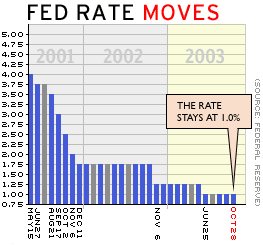NEW YORK (CNN/Money) -
Federal Reserve policy-makers held a key short-term interest rate steady on Tuesday, saying they still were concerned about a drop in inflation despite signs of strength in the world's largest economy.
The Fed's policy-making Federal Open Market Committee (FOMC) unanimously agreed to leave its target for the federal funds rate, an overnight bank lending rate that affects other key bank rates, at 1 percent -- the lowest in more than 42 years.
At its last policy meeting, in September, the FOMC also left rates alone.
In its statement, closely watched by investors for clues about future policy, the Fed said that even though consumer and business spending have improved and the labor market has stabilized, it still was worried about a dangerous and unwelcome fall in already-low inflation.
"The Committee judges that, on balance, the risk of inflation becoming undesirably low remains the predominant concern for the foreseeable future," the statement said. "In these circumstances, the Committee believes that policy accommodation can be maintained for a considerable period."
Translation: The Fed, the nation's central bank, is likely to hold interest rates at rock bottom for as long as possible.
The Fed's action was widely expected, and U.S. stocks continued to trade higher after the announcement, while Treasury bond prices reversed course and rose.

The Fed's statement, which was only mildly positive, relative to the rosier forecasts of some Wall Street economists, was apparently worded with an eye on financial markets, the Treasury bond market in particular.
This summer, many analysts said, the Fed had not effectively signaled its intention to keep rates low for a long time, thus unintentionally allowing long-term rates to rise in the bond market.
Many observers feared that an overly optimistic outlook from the Fed on Tuesday might have triggered a sell-off in the bond market, pushing long-term interest rates so high that they would slow the economy.
| Related stories
|

|
|
|
|
"Fed officials do not want to risk overreaction by the markets," Goldman Sachs economist Ed McKelvey said in a recent research note. "This would undermine financial conditions at a time when the Fed needs growth to stay above its potential rate."
The central bank seems unlikely to move from its cautious position until it sees more evidence that the labor market, which has been mired in its longest slump since the Great Depression, has turned around more fully.
New weekly claims for unemployment benefits have fallen and payrolls grew in September for the first time since January. But the kind of job growth necessary to keep up with population growth and bring the unemployment rate down is still only a promise, not a reality.
Still, some economists worry the Fed risks losing credibility -- and its influence on the Treasury bond market, in particular -- if it fails to be more optimistic in the face of stronger economic data such as Tuesday's report of rising durable goods orders.
If bond markets decide much stronger economic growth is in the cards, they could push long-term rates higher to keep up with inflation expectations, no matter what the Fed says or does.
"The upcoming data will soon enough force the Fed to change its stance, otherwise it will begin to look ridiculous," said Ian Shepherdson, chief U.S. economist at High Frequency Economics Ltd.
If the Fed is forced to adjust its outlook, it will nevertheless need to do so carefully. Its next move may be to convince the market that its key short-term rate can rise a bit and still be considered "accommodative" to growth, as long as it stays below the rate of inflation.
"Simply because the Fed is maintaining an accommodative monetary policy position doesn't mean they keep the fed funds rate at one percent indefinitely," Mike Ryan, senior fixed income strategist at UBS, told CNNfn.
A recent speech by San Francisco Fed President Robert Parry hinted at such a move, and Fed speeches in coming weeks could bring more of the same.
At its next policy meeting, scheduled for December, the Fed might also drop the statement that it can stay on hold for a "considerable period," -- words some Fed officials objected to when they were included in the September statement, according to a recent Wall Street Journal report.
"[The economic recovery] sure looks to be here, but once [Fed officials] recognize that fact, rates, including the fed funds rate, could jump," said Joel Naroff, president and chief economist at Naroff Economic Advisors in Holland, Pa. "That is the box the FOMC has gotten itself into with their statement that policy accommodation can be maintained for 'a considerable period.'"

|

